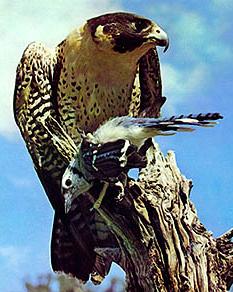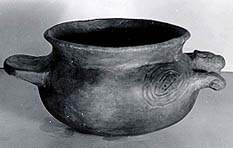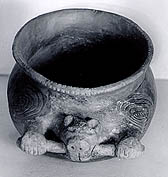
The falcon was a favorite Mississippian image variously used to symbolize the upper world and the political and military power of the chief. In particular note the hooked beak and the "forked-eye" markings on the head.
Significantly, another aspect of the Mississippian ideological structure is the physical world occupied by people, the place that divides the upper world from the lower (Emerson 1997). This tripartite view of the world is important because it indicates that people interact with forces and beings from both worlds. According to some interpretations, the religious focus of these interactions and communication between the worlds took place at the cardinal directions on the horizon and on the tops of important mounds.

Beings that dive in the water - icons of the lower, water world. Beaver effigy pot from Cahokia. Note also the curvilinear swirls, a design believed to be associated with water.

Front view of beaver pot shown above.